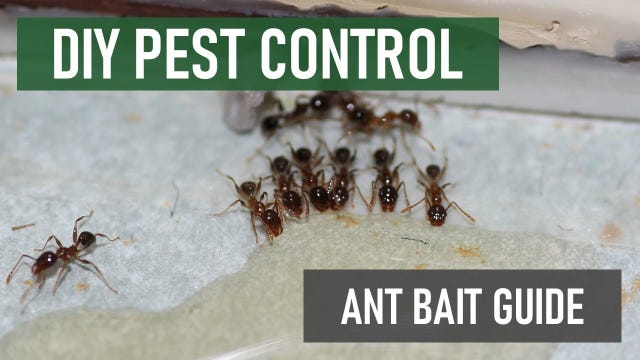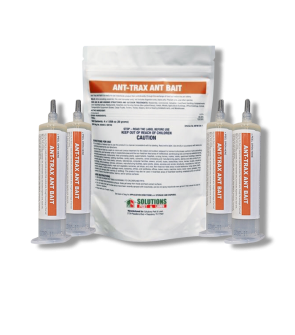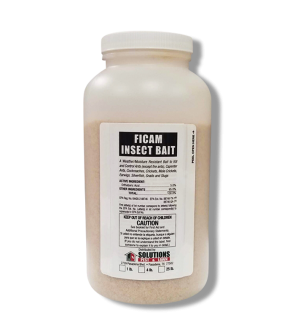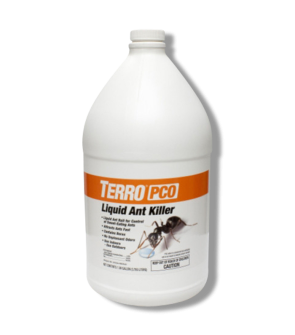Gain access to personalized product screening, the best pricing, rewards, and more!
Most Effective Products
Ant Bait Guide: How to Kill Entire Ant Colony By Baiting
This page is an expert guide on getting rid of ants from your home and yard with professional ant baits. Follow this easy-to-use guide and use the recommended products, and we guarantee you will be successful in controlling ant populations by learning more about ant baits and the pest itself.
When homeowners hear the term baiting, they often imagine placing a food source with an insecticide to eliminate ants. However, this method is not entirely successful and often leads to a more serious infestation. While there are many ways to create your own ant bait, using a professional ant bait is one of the easiest and guaranteed methods against ant infestations.
As strange as it may sound, you do not want to kill ants too quickly or disturb their mounds, as this will only spread the ants further on your property. Additionally, the ants you are seeing are only the worker ants. Just by killing the visible worker ants, you do not kill the entire colony, which is where the use of ant baits comes into play.
Controlling ants can be a very difficult process and requires a combination of cultural, sanitization, chemical treatments, and, lastly, your patience. There are many things to consider when picking the best ant bait for your home infestation, but choosing a bait can be done by following this DIY guide.
What Are Ant Baits
An ant bait consists of an active ingredient from a pesticide or toxicant, usually mixed with an attractant from a food ingredient. Ant baits are available in several different formulations, including liquid baits, gel baits, bait granules, bait dusts, or containerized bait stations prefilled with bait, which are often called ant traps.
Liquid Ant Baits: pesticides formulated in a liquid form that sometimes needs to be mixed with water and placed in a specific bait station. Depending on the manufacturer, most liquid ant baits are mainly concentrated with sugar solutions to attract and eliminate sweet-feeding ants and not many other ant species.
Gel Ant Baits: a thick or syrup-like pesticide material in a prefilled bottle, syringe, or small tube to be discreetly applied in hard-to-reach cracks, crevices, voids, or on ant trails. This type of ant bait is more commonly used as it can easily be applied to indoor or outdoor cracks and crevices and controls most ant species.
Bait Ant Granules: simply small to medium-size granules formulated with only insecticides and not attractants. Unlike other baits, bait granules mainly work as direct toxicants when ants come into contact with the material. They will then digest the granules and perish, or it may cause immature stages of ants to stop growing before sexual maturity and/or the queen ant to be sterile as it may be formulated as an insect growth regulator. These types of baits are not to be confused with granular insecticides, which function more as a repellent contact insecticide, while granular baits function by ingestion and transfer.
Bait Ant Dust/Powders: these are like granules that kill ants by contact and contain no attractants, except they are formulated as a light, fine powder. Ant dust baits work exceptionally well in confined spaces or specific isolated areas such as wall voids, electrical outlets, or direct application on ant mounds depending on the label. In contrast, bait ant granules can be applied more to open spaces such as around a homes perimeter, into the soil, and outdoor or indoor crevices depending on how its labeled.
Ant Bait Traps: This is a type of liquid ant bait enclosed in a plastic container; however, ants will not be trapped. It lures the ants into the container towards the bait and allows them to bring it back to the inside of its ant mound to spread to other colony members. Depending on the ant bait trap, they are a mixture of proteins or carbohydrates (sugars, starches, cellulose) and some type of toxicant. Compared to other types of ant baits, this type of bait is limited to small treatment areas and cannot be used for large treatment areas or enclosed spaces.
How Ant Baits Work
Most ant baits come pre-packaged or already formulated with a mixture of an insecticide or toxicant and food attractant. Often, ants will bring the bait material back to the colony to share with other ant members and the queen, slowly killing them off one by one. Baits are usually slow-acting, so the foraging ants have time to make their way back to the nest and feed other members of the colony.
Most gel baits are sugar-based, whereas most granular baits are protein-based.
What is the Best Ant Bait to Use
Some types of ant baits have advantages over other types of baits. What is critical to remember that determining which ant bait is the best will be based on the ant species.
Generally, ants will fall into two categories: sugar-feeding ants or protein-feeding ants.
Sugar ants seek out all types of sugar-based foods, such as spilled juice, raw sugar, fruit, or honeydew made by other insects. Protein feeder ants, or just regular ants, are known to feed on insects, dead or alive, meats, greasy foods, bread, and more. However, both types of ants may not feed exclusively on one food source, meaning that a sugar ant will still feed on protein foods and protein-feeding ants on sweet food sources, depending on the species.
Determining what type of ant species you have in and around your home will depend on several factors, such as the location where foraging ants are found or their nests, the appearance of the pest, and your geographical location within the United States. There are several ant species, but they can easily be identified in our ant control guide.
Take note of what type of food the ant is feeding on, as this may help determine whether it is a sugar ant or a protein-feeding ant.
What is Ant Bait Made of
When deciding between ant bait products, consider the active ingredient. The active ingredient is the specific compounds or components of the bait that kill or control the ant.
Most ant baits comprise a rather small portion of the active ingredient, and the rest contain either carbohydrates, proteins, oils, or a combination of both. While the active ingredient will tell you how and why the bait will impact the ants, the other ingredients will determine if the bait will be consumed.
Look for active ingredients on the ant bait product label and learn more about each active ingredient difference, as it may be the key to colony elimination and long-term relief.
Hydramethylnon is an organic compound of the chemical class trifluoromethyl aminohydrazone and functions as a metabolic inhibitor. As an ant bait, it will spread over where ants are foraging and then interfere with the ant's cell ability, leading to the inability to digest food. This condition usually occurs in approximately 72 hours, resulting in the ant's death.
Fipronil is a phenylpyrazole chemical used to control a wide variety of pests, including ants. This insecticide is relatively new to the pesticide industry, and it kills ants by ingestion or when they come into contact with this active ingredient. When ants come into contact with this chemical, it disrupts their central nervous system, leading to hyperexcitation of the insect's nerves and muscles. Depending on its formulation, Fipronil can take several minutes or hours to kill ants. This type of active ingredient is often used because it is non-repellent, allowing ants to contact treated areas without repelling them for effective elimination.
Boric Acid (borate) is the most common active ingredient in ant baits. Boric acid is a naturally occurring chemical in soil, water, and plants. While this active ingredient mainly functions as a stomach toxicant, it also hinders the ant's nervous system when ingested. An irritant, boric acid is also known to harm an ant's exoskeleton. Each of these functions results in the death of ants within 24 to 28 hours.
Abamectin is a type of nerve poison derived from the soil bacterium Streptomyces avermitilis. Although it is a natural fermentation of this bacterium, it is still classified as a toxicant. It attacks the nervous system of ants, causing paralysis within hours and then death within 3 to 4 days.
Indoxacarb is a relatively new chemical in the oxadiazine family. It works by blocking sodium channels in the ants' nervous systems when they come into contact with it or ingest the white powdered solid material. This process begins immediately, but it does not provide an instant kill to ants; instead, it could take 3-10 days for their death.
Thiamethoxam is a second-generation neonicotinoid compound belonging to the new chemical subclass thianicotinyls. This chemical causes certain types of receptors in the ants' nervous system to overstimulate their nerve cells, resulting in paralysis and eventual death within 3 to 5 days.
Pyriproxyfen is a broad-spectrum insect growth regulator that mimics the natural hormone in ants and disrupts their growth. It does not kill ants, but it stops immature ant stages from reaching sexual adulthood and stunts the queen ants' ability to lay eggs, thus stopping future generations of ants.
Where to Apply Ant Baits

Before you set your ant bait, ensure no other food options are available in the treatment area by wiping down surfaces with a wet rag to remove crumbs or food odors.
Avoid soap, bleach, or other chemical products, as these could interfere with your ant bait's success. Store exposable food in sealable plastic containers and properly dispose of exposed, uneaten pet food to limit food competition.
Follow the application sites stated on your ant bait label. Still, most ant baits will be placed closest to where the pests are most active and where ant activity is most likely to occur, such as around drains or in cabinets, directly on ant trails, or in areas where ants are likely to enter your home.
Be sure to place baits in areas inaccessible to children and pets.
How to Use Ants Baits
Before applying and handling any ant bait, you must wear the proper personal protective equipment (PPE).
Depending on your preference and ant species will determine which ant bait to use. We recommend using slow-acting gel bait as they are more diverse in application sites and allow the bait to be thoroughly distributed throughout the entire colony.
This section will specifically focus on gelt baits, granular baits, and liquid baits.
Ant-Trax Ant Bait is a versatile, ready-to-use ant bait gel that eliminates many kinds of ants indoors and outdoors. We suggest Ficam Insect Bait as a granule bait application against ants like carpenter ants or Terro PCO Liquid Ant Bait as a liquid ant bait option for sweet-feeding ants.
Step 1: Determine How Much Ant Bait to Use

Figure out how much ant bait to use by measuring the square footage of the treatment area. To do this, measure the length and width of the treatment area in feet, then multiply them together (length X width = square footage). For acreage, divide the square footage by one acre (square footage / 43,560 sq. ft. = acres).
Keep in mind that bait is an attractant. If you use too much, you could attract other pests like cockroaches. However, if you use too little, your current ant infestation will seek out other food sources before the queen ant can be killed.
Step 2: Set-Up Gel Bait
If you are using an ant bait gel like Ant-Trax Ant Bait, you will apply 4 pea-size drops of product per square yard of treatment area. Place the Ant-Trax Ant Bait closer to ant trails and areas of activity. Numerous small Ant-Trax Ant Bait placements will provide quicker control than large bait placements.
Step 3: Set-Up Granular Bait
Ficam Insect Bait is a ready-to-use granular insecticide bait that kills many crawling pests, including ants. Its active ingredient is orthoboric acid 5.0%.
Apply Ficam Insect Bait at a rate of 6 oz. per 100 sq. ft. of treatment area. Spread the product granules where you have seen ant trails and areas you suspect have an ant infestation.
For an outdoor perimeter application against ants, apply at the rate of 4 lbs. of product per 1,000 sq. ft. of your home perimeter.
Step 4: Set-Up Liquid Bait
Terro PCO Liquid Ant Bait is a borate-based liquid ant bait that attracts sweet-feeding ants, such as white-footed ants. Like other liquid baits, this product must be diluted with water and placed in a specific ant bait station to be used.
Depending on the severity of your ant infestation, use a 1% dilution of Terro PCO Liquid Ant Bait for mild ant infestations or a 2% dilution of this product for severe ant infestations.
To achieve a 1% dilution of Terro PCO Liquid Ant Bait, mix 5 fl. oz. of product with 25 fl. oz. of water to attain 1 quart of finished product. For a 2% dilution of Terro PCO Liquid Ant Bait, mix 10 fl. oz. of product with 20 fl. oz. of water to attain 1 quart of finished product.
How to Know if Ant Bait is Working
It may be alarming initially, but a sudden increase of ants when the bait is first placed is expected. When ants travel to and from the bait, they leave behind a pheromone trail that lets other worker ants know where to find the available food supply. This explains why, at first, you will see more ants when using ant baits.
Based on the active ingredient of the ant bait, its formulation type, and additional available food sources will determine how long it will take for ants to be eliminated.
Consider additional cleaning methods like wiping down counter and pantry shelves, sweeping and vacuuming floors, and placing food in sealable plastic containers to increase your ant elimination efforts. Other methods, such as sealing cracks and crevices on the outside and inside of your home with caulk, will stop ants from entering or nesting near your home.
Consider that using insecticides, cleaning agents, detergents, and exposed food sources will deter ants from the baits being used.
Key Takeaways
Will Ant Bait Bring in More Ants
- Ant baits are designed to attract ants, so you may see an increase in the ant population from when the bait was placed. However, after the labeled days, the bait should reach the colony for complete elimination.
Can Ant Bait Be Used Outdoors
- Depending on the manufacturer, most ant baits can be used outside. For serious ant infestations, we recommend using granule baits like Ficam Insect Bait for perimeter applications and larger treatment areas against ants. Baits such as liquid ant baits or ant bait traps are more for indoor than outdoor ant control.
Is Ant Bait Safe for Pets
- Ant Baits are safe for children and pets when applied according to their product label instructions. Always wear the proper personal protective equipment (PPE) when handling and applying the product. Some ant baits, such as Terro PCO Liquid Ant Bait, must be used in an ant bait station.













